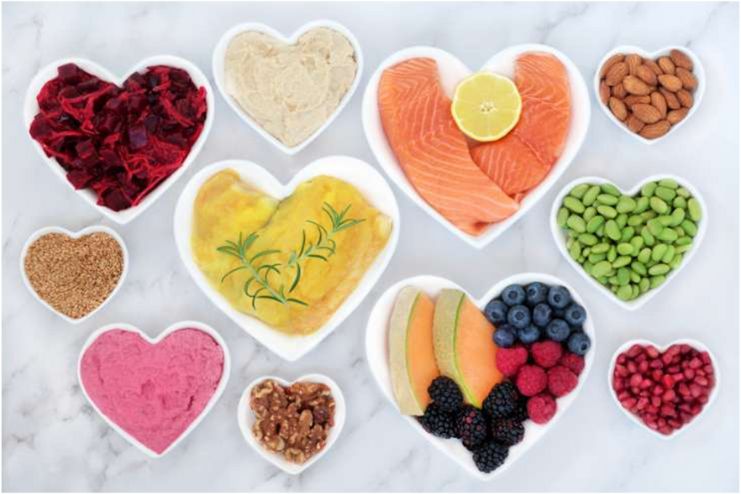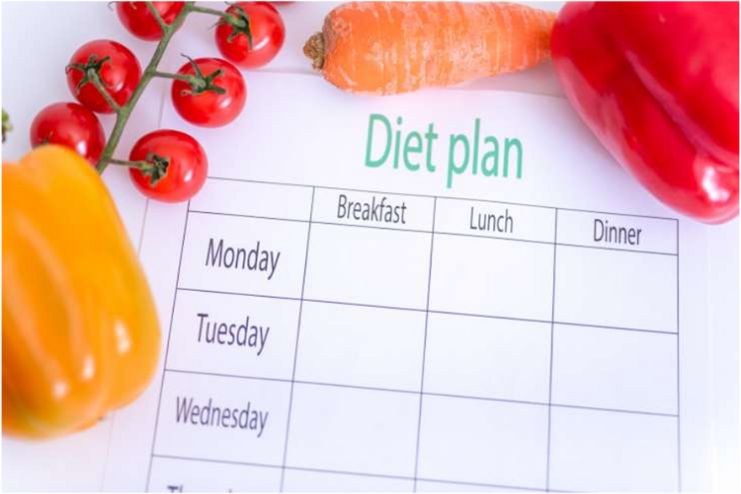Affiliate Disclaimer
Some links in this article are affiliate links. We may earn a small commission if you make a purchase through these links, at no extra cost to you. We only recommend products we find useful to our readersOverall, your health depends on having a healthy heart; eating a balanced diet is one of the best ways to keep your heart healthy. Poor dietary choices can result in a higher risk of cardiovascular conditions, such as heart attacks, strokes, and hypertension.
Our diet significantly impacts blood pressure, inflammation, and cholesterol—all of which are important aspects of heart health. We can safeguard and nourish our hearts by emphasizing nutrient-dense foods and avoiding dangerous chemicals like too much salt, saturated fats, and processed carbohydrates.
Knowing which foods promote cardiovascular health is essential to lower the risk of heart disease and promote long-term heart function. This article will list some of the best heart-healthy foods you should include in your diet to help you keep your cardiovascular system robust and healthy.
Read More: Managing Stress for a Healthy Heart: Techniques for Better Mental Health
Top Heart-Healthy Foods

Maintaining a heart-healthy diet involves including a range of nutrient-dense foods that promote cardiovascular health. Eating heart-healthy entails minimizing meals with added sugars and saturated fats while consuming more fruits and vegetables.
Research shows that the Dietary Approaches to Stop Hypertension (DASH) diet plan reduces high blood pressure and “bad” LDL cholesterol in the blood, so your doctor may suggest it.
Vegetables and Fruits:
Studies consistently link a diet high in fruits and vegetables to lower the risk of cardiovascular disease. Fruits and vegetables are crucial for heart health because they include antioxidants that can help prevent artery damage. Eat a range of fresh, tinned, and frozen fruits and vegetables. Some options include:
- Fresh veggies include carrots, edamame, okra, tomatoes, and cabbage.
- Leafy greens include bok choy, kale, spinach, and romaine lettuce.
- Broccoli and cauliflower are examples of frozen veggies that don’t have any additional butter or sauces.
- Fresh fruits include apples, oranges, bananas, papayas, mangoes, and guavas.
- Dried, frozen, or canned fruit without extra sugar retains its nutritional benefits.
Whole grains:
Fiber is abundant in whole grains and lowers the risk of heart disease by assisting in maintaining healthy cholesterol levels. You can reduce your risk of coronary heart disease by switching to whole grains instead of processed ones. Heart-health options include:
- Wholegrain tortillas, bagels, English muffins, and bread.
- Sugar-free wholegrain breakfast cereals, such as oatmeal or shredded wheat, can be consumed hot or cold.
- Whole grains like quinoa, oats, or brown or wild rice.
- Couscous and whole-wheat or wholegrain pasta.
Low-fat and Nonfat dairy:
Switching from full-fat to low-fat dairy products is a heart-healthy choice that helps reduce saturated fat and enhance unsaturated fat consumption. Try these dairy options:
- Low-fat (1%) or fat-free milk.
- Low-fat or fat-free plain yogurt.
- Cottage cheese, low-fat cheese, or cheese without fat.
- Fortified soy milk or soy yogurt provides added nutrients.
Lean Proteins:
Fish and plant-based proteins such as legumes and nuts are great for your heart. These foods decrease the risk of cardiovascular disease. Here are some lean protein options:
- Common legumes such as split peas, lentils, chickpeas, various beans, and soybeans (edamame and tofu).
- Omega-3 fatty acids, including sardines, mackerel, and salmon, are abundant in oily fish.
- Lean ground chicken or turkey (at least 93% lean) or skinless chicken or turkey breast.
Including these heart-healthy food options in your diet can significantly improve cardiovascular health by lowering cholesterol, regulating blood pressure, and reducing inflammation.
Read More: Hearty and Healthy Soups: Warm Bowls for Nourishing Comfort
Limiting Heart Disease Risk

Limiting or avoiding certain substances that can harm cardiovascular health is as important as incorporating heart-healthy items into your diet. Foods that are heavy in sodium, trans fats, saturated fats, and added sugars can raise blood pressure, cholesterol, and inflammation, all of which can lead to heart disease.
Saturated Fats: Red meat, full-fat dairy products, and processed food are the primary sources of saturated fats, which can increase “bad” LDL cholesterol levels. Plaque formation from this accumulation of LDL cholesterol in the arteries can restrict blood vessels and raise the risk of heart attack and stroke.
Trans fats: Similar to saturated fats, trans fats tend to lower HDL (good) cholesterol levels while simultaneously raising LDL (bad) cholesterol levels. Therefore, they can increase our risk of cardiovascular diseases (like heart disease and stroke). Hydrogenating and solidifying monounsaturated or polyunsaturated vegetable oils to create margarine, deep-frying oils, and shortening for baked goods produces trans fatty acids, so it’s best to avoid these.
Sodium: The body retains too much fluid when you consume too much salt, which is abundant in processed foods, canned soups, and restaurant meals. It can raise blood pressure. One important risk factor for heart disease is high blood pressure. Cooking more food at home with all fresh ingredients, adding herbs and spices for flavor, and selecting low-sodium substitutes when they are available are all ways to lower sodium intake.
Added Sugars: Consuming too many sugary meals and drinks can raise triglyceride levels, cause weight gain, and cause insulin resistance, all of which are heart disease risk factors. Choose fresh fruits or unsweetened snacks to cut back on sugary snacks, sodas, and sweets.
Read More: Top 10 Heart-Healthy Cookware Essentials for Every Kitchen
A Heart-Healthy Diet Plan

Including nutrient-dense foods in daily meals while adhering to portion management and balanced nutrition is essential to developing a heart-healthy diet. A well-planned diet should include a variety of fruits, vegetables, whole grains, lean meats, and healthy fats to support cardiovascular health.
Advice for a Heart-Healthy Diet:
- Half of your plate should be filled with fruits and vegetables to increase fiber, antioxidants, and vital vitamins.
- Instead of processed grains, choose healthy grains like quinoa, brown rice, and whole-wheat bread.
- Reduce your intake of red and processed meat, and increase your intake of lean proteins like fish, chicken, legumes, and tofu.
- Instead of trans and saturated fats, choose healthy fats from nuts, seeds, olive oil, and fatty fish.
- Check food labels and cook at home to reduce extra sugars and sodium.
An example of a heart-healthy diet:
Breakfast:
- One cup of cooked oatmeal topped with one teaspoon of cinnamon and one tablespoon of chopped walnuts.
- One banana
- One cup of skim milk
Lunch:
- Roasted broccoli, quinoa, and grilled salmon.
- A side salad dressed with lemon juice and olive oil.
Afternoon Snack:
- Two teaspoons of mixed, unsalted nuts.
- One cup of frozen yogurt without fat.
Dinner:
- Brown rice, steamed asparagus, and grilled chicken breast.
- Dessert is a little portion of dark chocolate (80% cacao).
Adhering to a heart-healthy eating plan emphasizing portion control and balanced meals can reduce your risk of heart disease while still allowing you to indulge in wholesome and delectable foods.
Cooking and Preparation Tips

By using heart-healthy cooking techniques, you can keep the vital nutrients in your food while drastically lowering bad fats, extra sodium, and added sweets. Modest dietary adjustments can have a long-term effect on heart health.
Healthy Cooking Techniques:
- Roasting and Grilling: These methods preserve the natural flavors and nutrients of foods, including fish, poultry, and vegetables, while using little to no extra fat.
- Steaming: Compared to boiling, steaming retains vitamins and minerals better, which makes it an excellent option for whole grains, fish, and vegetables.
- Sautéing with Healthy Oils: To prepare lean proteins and veggies, use heart-healthy oils like avocado or olive oil rather than butter or lard.
- Slow Cooking: Slow cooking reduces the need for added fats or salt by letting flavors develop organically and preserving nutrients.
- Air-Frying: Instead of deep-frying, try air-frying or roasting.
- Seasoning: Steer clear of prepackaged seasonings that can have too much sodium and preservatives.
You may promote cardiovascular health and enjoy tasty, nourishing meals using these heart-healthy cooking techniques.
Read More: 7 Heart-Healthy Habits You Can Adopt in Under 5 Minutes a Day
Conclusion
Your heart works for you with every beat and every second. Giving it the proper nourishment is a commitment to a longer, better life, not just a decision. Making wise, delectable, and nutritious decisions, not following rigorous rules, constitutes a heart-healthy diet. Choosing foods high in nutrients, avoiding unhealthy additives, and cooking with awareness lays the groundwork for long-term cardiovascular health.
You can nourish your heart with love and care at every meal. Thus, make informed decisions, enjoy mindfully, and allow your nutrition to be the secret to a healthy, happy future. Give your heart the best; it deserves nothing less!
References
- https://odphp.health.gov/myhealthfinder/health-conditions/heart-health/heart-healthy-foods-shopping-list
- https://www.nhlbi.nih.gov/health/heart-healthy-living/healthy-foods
- https://www.mayoclinic.org/diseases-conditions/heart-disease/in-depth/heart-healthy-diet/art-20047702
- https://www.health.harvard.edu/heart-health/heart-healthy-foods-what-to-eat-and-what-to-avoid
- https://www.healthline.com/nutrition/heart-healthy-foods
- https://www.cdc.gov/heart-disease/prevention/index.html
- https://www.betterhealth.vic.gov.au/health/conditionsandtreatments/diet-and-heart-disease-risk
- https://nutritionsource.hsph.harvard.edu/disease-prevention/cardiovascular-disease/preventing-cvd
- https://www.mdanderson.org/cancerwise/cardiac-diet-heart-healthy-diet-what-is-it–what-can-you-eat-and-what-should-you-avoid.h00-159539745.html
- https://www.mayoclinic.org/diseases-conditions/heart-disease/in-depth/heart-healthy-diet/art-20046702
- https://www.eatingwell.com/article/289245/7-day-heart-healthy-meal-plan-1200-calories
- https://www.eatingwell.com/article/7884046/heart-healthy-diet-plan-for-beginners
In this Article


















